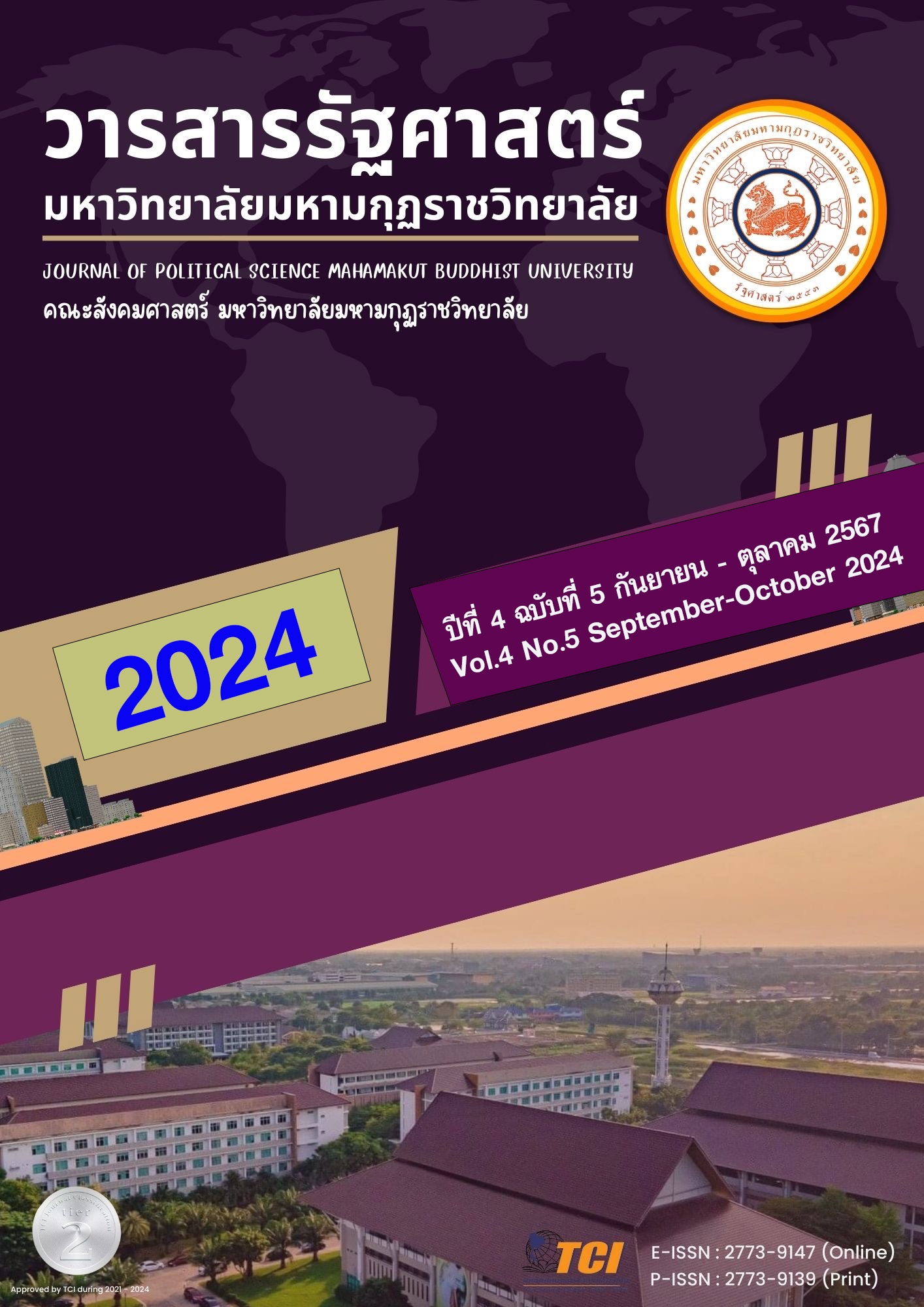LOCAL POLITICS AND THE MANAGEMENT OF BUDDHIST TOURISM ALONG THE MEKONG RIVER ROUTE IN THE THAI-LAO BORDER AREA, NONG KHAI PROVINCE
Main Article Content
Abstract
This research article focuses on three main objectives: (1) to analyze the management conditions, problems, and obstacles in promoting Buddhist tourism along the Mekong River route, (2) to examine the factors affecting local governance and the management of Buddhist tourism in the area, and (3) to develop strategic guidelines for local governance that align with Buddhist tourism management. A mixed-methods approach was used, with qualitative data collected through in-depth interviews with 12 key informants and focus group discussions with 12 experts. The data were analyzed using content analysis and presented descriptively. Quantitative data were gathered through surveys of 382 tourists from five temples along the Mekong River route in the Thai-Lao border area. A stratified sampling method was employed to ensure comprehensive coverage, followed by descriptive and inferential statistical analysis and structural equation modeling (SEM) using the AMOS software.
The research findings are as follows:
1) The management conditions, problems, and obstacles in promoting Buddhist tourism can be categorized into three key factors: external, internal, and supportive factors, consisting of six main areas: 1.1) tourist site attractiveness, 1.2) environmental conditions of the site, 1.3) marketing promotion, 1.4) types of tourism activities, 1.5) tourist motivation, and 1.6) supplementary services at the tourist site.
2) The capacity of temples along the Mekong River to promote tourism is indicated by four key factors: 2.1) environmental management, 2.2) cultural and local lifestyle values, 2.3) site management, and 2.4) historical significance.
3) The development of strategic guidelines for local governance to support Buddhist tourism consists of two main components, ten sub-components, and 75 indicators, all of which were validated through structural equation modeling (SEM).
Article Details

This work is licensed under a Creative Commons Attribution-NonCommercial-NoDerivatives 4.0 International License.
References
กรมการศาสนา. (2533). การประเมินผลงานการจัดบรรพชาอุปสมบทภาคฤดูร้อน ประจำปี 2533. กรุงเทพมหานคร: โรงพิมพ์กรมการศาสนา.
ฉันทัช วรรณถนอม. (2564). ความหมายและความสำคัญของอุตสาหกรรมการท่องเที่ยว. เรียกใช้เมื่อ 11 มกราคม 2566 จาก https://tourismatbuu.wordpress.com
ชมพูนุช จิตติถาวร. (2555). ความรูเบื้องตนเกี่ยวกับการจัดประชุม นิทรรศการ และการทองเที่ยวเพื่อเปนรางวัล. (พิมพครั้งที่ 2). นนทบุรี: มหาวิทยาลัยสุโขทัยธรรมาธิราช.
ทวีป สิริรัศมีทวีป ศิริรัศมี และพชรวรรณ สุขหมื่น. (2550). การท่องเที่ยวชายแดนไทยกับประเทศเพื่อนบ้าน, นนทบุรี: สำนักพิมพ์ พี เอส.พริ้นท์.
นิตยา เพ็ญศิรินภา และสุรชาติ ณ หนองคาย. (2554). พฤติกรรมองค์การและการจัดการทรัพยากรมนุษย์. นนทบุรี: มหาวิทยาลัยสุโขทัยธรรมาธิราช.
บุญชม ศรีสะอาด. (2553). การวิจัยเบื้องต้น. (พิมพ์ครั้งที่ 8). กรุงเทพมหานคร: สุวีริยสาสน์.
บุญเลิศ จิตตั้งวัฒนา. (2549). การวางแผนพัฒนาการทองเที่ยวแบบยั่งยืน. เชียงใหม่: มหาวิทยาลัยเชียงใหม.
บุญเพ็ง สิทธิวงษา,กนกอร บุญมี และ บุญช่วย กิตติวิชญกุล. (2566). การขับเคลื่อนธุรกิจ SMEs สตาร์ทอัพในการใช้นวัตกรรมแก้จนของประชาชนในพื้นภาคตะวันออกเฉียงเหนือตอนบนประเทศไทย. วารสารส่งเสริมและพัฒนาวิชาการสมัยใหม่, 1(5), 1-16.
พระมหาสุทิตย์ อบอุน. (2542). การท่องเที่ยวแนวพุทธ. จุลสารการทองเที่ยว, 18,(2).
มหาวิทยาลัยมหาจุฬาลงกรณราชวิทยาลัย. (2539). พระไตรปิฎกภาษาไทยฉบับมหาจุฬาลงกรณราชวิทยาลัย. กรุงเทพมาานคร: โรงพิมพ์มหาจุฬาลงกรณราชวิทยาลัย.
มาฆะ ขิตตะสังคะ และคณะ. (ม.ป.ป.). การศึกษาการพัฒนาศักยภาพการบริหารจัดการการท่องเที่ยวเชิงวัฒนธรรมในพื้นที่ภาคเหนือตอนบน กรณีศึกษาจังหวัดเชียงราย เชียงใหม่ และแม่ฮ่องสอน. เชียงราย: มหาวิทยาลัยราชภัฏเชียงราย.
มิศรา สามารถ. (2543). การมีส่วนร่วมของชุมชนท้องถิ่นในการบริหารจัดการด้านการท่องเที่ยวเชิงนิเวศ. กรุงเทพมหานคร: สถาบันดํารงราชานุภาพ สํานักงานปลัดกระทรวงมหาดไทย.
วิภา ศรีระทุ. (2551). ศักยภาพแหล่งท่องเที่ยวเชิงนิเวศน์ในอำเภอเขาค้อ จังหวัดเพชรบูรณ์. ใน สารนิพนธ์วิทยาศาสตรมหาบัณฑิต. การวางแผนและการจัดการการท่องเที่ยวเพื่ออนุรักษ์สิ่งแวดล้อม. มหาวิทยาลัยศรีนครินทรวิโรฒ.
เอกรินทร์ พึ่งประชา. (2550). มรดกโลก มรดกแห่งมนุษยชาติ. กรุงเทพมหานคร: ปาเจรา.


